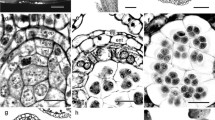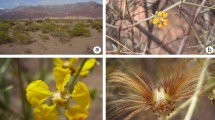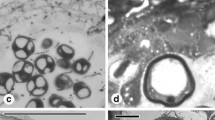Abstract
To confirm the taxonomic treatment ofMegaleranthis saniculifolia Ohwi, an endemic genus and species in Korea, we compared its reproductive morphological characteristics with those ofTrollius and other genera within the Ranunculaceae. Although its external morphology might suggest thatMegaleranthis differs fromTrollius, Calathodes, and etc., we found no distinctly different features in this genus. Likewise, previous studies of their pollen structures, chromosome data, and petal morphology have indicated no differences betweenMegaleranthis andTrollius. In fact, related genera share similar characteristics, such as a tetrasporangia anther, glandular tapetum, simultaneous cytokinesis, an anatropous and bitegmic ovule, embryo sac formation of thePolygonum type, exarillate and copious albuminous seed, and several apocarps. Although the unique feature of having both tenuinucellate and crassinucellate ovules simultaneously may initially seem particular toMegaleranthis, it is present in other genera of the same family. Therefore, based on this evidence of reproductive morphology and other information, we suggest thatM. saniculifolia is closely related toTrollius, and should be included within that genus, i.e., asT. chosenensis Ohwi. Nevertheless, we have tentatively placedMegaleranthis within its own monotypic and endemic genus until definitive data become available.
Similar content being viewed by others
Literature Cited
Bhandari NN, Kapil RN (1964) Studies in the family Ranunculaceae. VII. Two types of embryo sacs inTrollius L. Beitr Biol Pflanzen 40: 113–120
Corner EJH (1976) The Seeds of Dicotyledons. Vol 2. Cambridge University Press, Cambridge, pp 8–24
Davis GL (1966) Systematic Embryology of the Angiosperms. John Wiley & Sons, New York, pp 8–11
Jalan S (1968) Some further observations on the embryology ofCaltha palustris L. Curr Sci 37: 621–623
Joan WN, Skvarla JJ (1979) Pollen morphology. The potential influence in higher orders systematics. Ann Missouri Bot Card 66: 633–700
Johri BM, Ambegaokar KB, Srivastava PS (1992) Comparative Embryology of Angiosperms. Vol 1. Springer-Ver-lag, Berlin, pp 285–291
Kadota Y (1996) Ranunculaceae. Botanical World (Weekly Magazine of Asahi News Paper Co., Japan) 92: 226–234
Kapil RN, Jalan S (1962) Studies in the family Ranunculaceae. I. The embryology ofCaltha palustris L. Plant embryology symposium, New Delhi, pp 205–214
Kim MY, Lee ST (1987) Palynotaxonomic relationship ofMegaleranthis saniculifolia Ohwi to the relative species (Ranunculaceae). Kor J Plant Tax 17: 13–20
Lee ST (1990) On the taxonomic position ofTrollius chosenensis Ohwi (Ranunculaceae). Kor j Plant Tax 20: 1–8
Lee TB (1980) Rare and endangered species in the area of Mt. Sorak. Bull Kwanak Arbor 3: 197–201
Lee WT (1969) A discussion on the Korean endemic genera. Kor J Plant Tax 1: 15–21
Lee YN, Yeau SH (1985) Taxonomic characters ofMegaleranthis saniculifolia Ohwi (Ranunculaceae). Kor J Plant Tax 15: 127–131
Ly TB (1961) Embryogenie des Renonculacees, developpement de I’embryon chez IeTrollius europaeus L. Compt Rend Hebd Seances Acad Sci 253: 2753–2755
Ohwi J (1935)Megaleranthis, genus novum Ranunculacearum. Acta Phytotax et Geobot 4: 130–131
Ohwi J (1937) Symbolae and Floram Asiae Orientalis 15. Acta Phytotax et Geobot 6: 151
Ro KE, Han HY, Lee ST (1999) Phylogenetic contributions of partial 26S rDNA sequences to the tribe Helleboreae (Ranunculaceae). Kor J Biol Sci 3: 9–15
Schmid R (1986) On Cornerian and other terminology of angiospermous and gymnospermous seed coats: Historical perspective and terminological recommendations. Taxon 35: 476–491
Tamura M (1966) Morphology, ecology and phylogeny of the Ranunculaceae. Sci Rep Osaka Univ 15: 13–35
Tamura M (1993) Ranunculaceae.In K Kubitzki, JG Rohwer, V Bittrich, eds, The Families and Genera of Vascular Plants. Vol 2. Springer-Verlag, Berlin, pp 563–583
Tamura M (1995) Die Naturlichen Pflanzenfamilien nebst ihren Gattungen und wichtigsten Arten, Band 17a IV,In P Hiepko, ed, Systematics: Ordnung Ranunculales, Family Ranunculaceae. Duncker und Humblot Verlag, Berlin, pp 225–247
Tobe H (1989) The embryology of angiosperms: Its broad application to the systematic and evolutionary study. Bot Mag (Tokyo) 102: 352–367
Yoo KO, Lee WT, Oh YJ (1999) External morphology and vegetation ofMegaleranthis saniculifolia populations in four different habitats. Kor J Plant Res 12: 312–323
Author information
Authors and Affiliations
Corresponding author
Rights and permissions
About this article
Cite this article
Jang, M.Y., Heo, K. Reproductive morphology ofMegaleranthis saniculifolia Ohwi (Ranunculaceae) and its systematic implications. J. Plant Biol. 48, 128–135 (2005). https://doi.org/10.1007/BF03030572
Received:
Accepted:
Issue Date:
DOI: https://doi.org/10.1007/BF03030572




